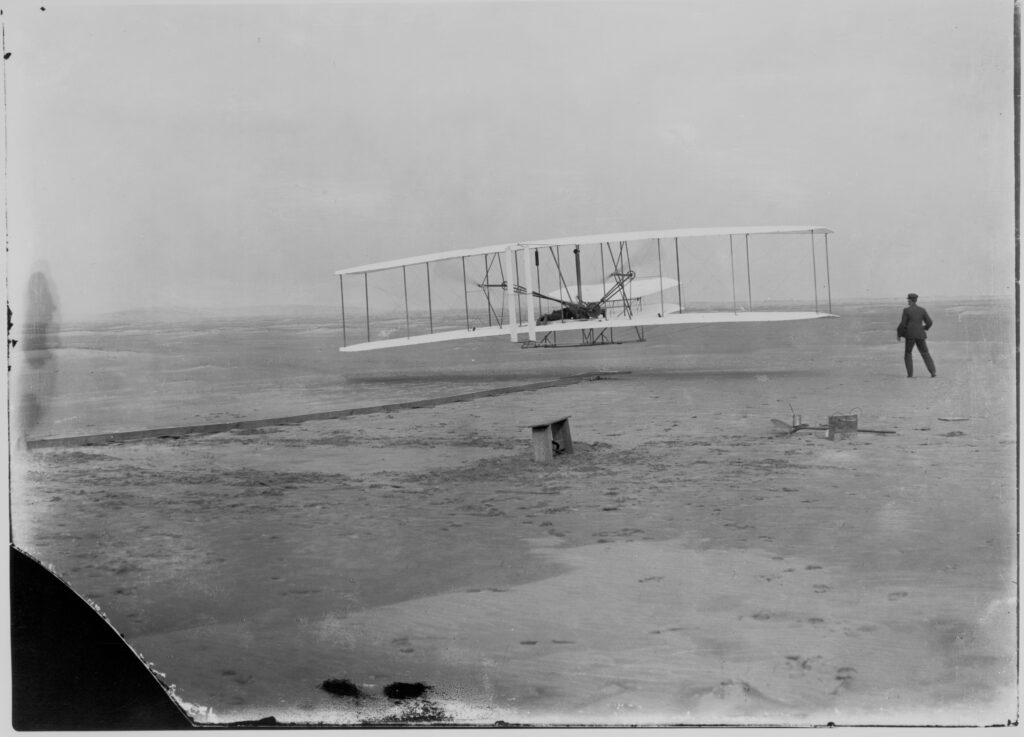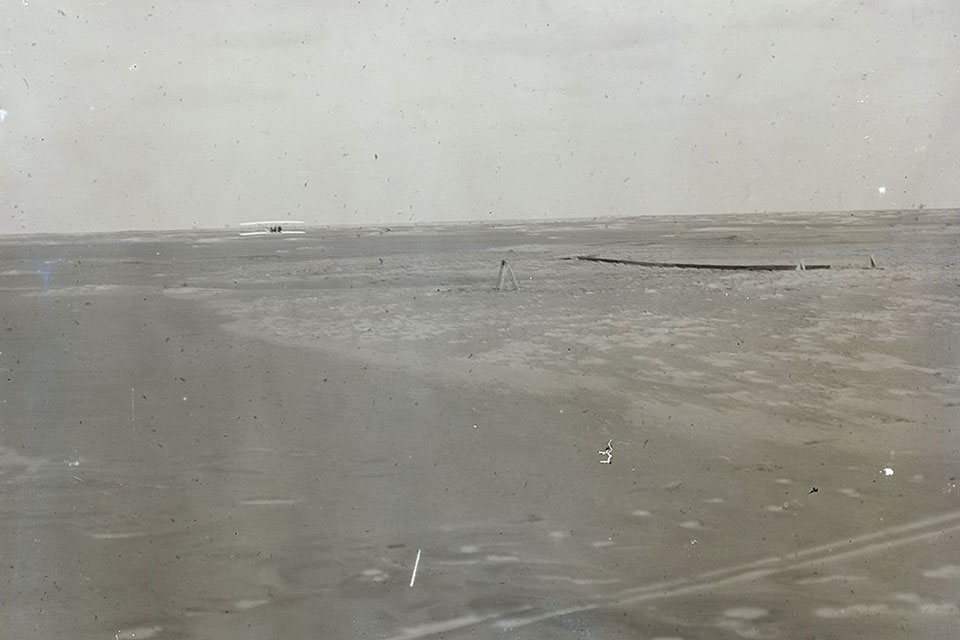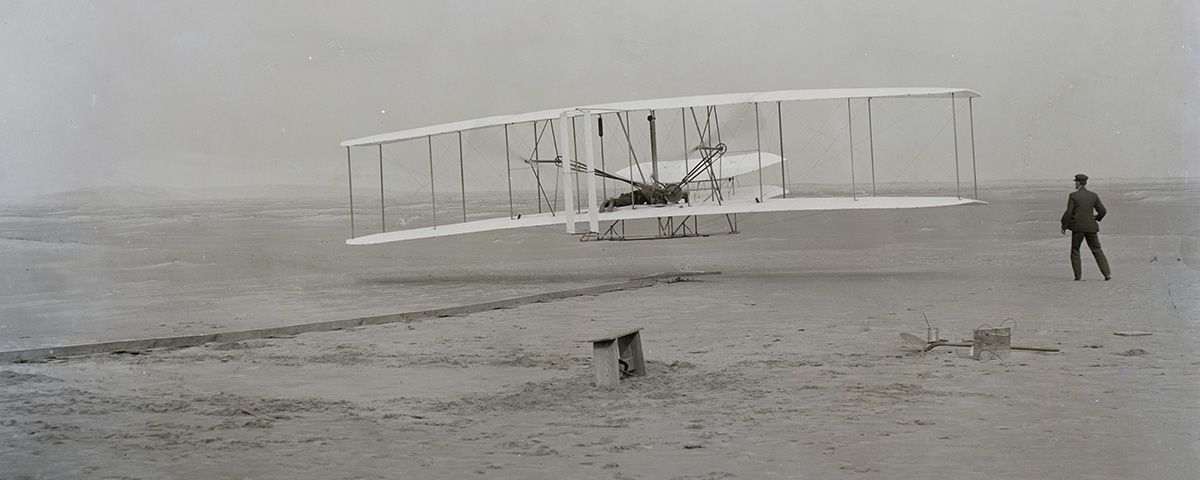Probably everyone in the developed world has seen the iconic picture of the first takeoff by the Wrights on December 17, 1903. The case could be made that it’s the most famous photograph of all time, with the possible exception of Neil Armstrong’s portrait of Buzz Aldrin on the moon. It shows the first powered Flyer just a couple feet off the ground, with Orville piloting and Wilbur running near the wingtip. This amazingly clear and sharp image has been widely represented as the moment of the birth of manned, powered flight. It seems incredibly fortuitous that such a good photo was taken at the precise instant in time that so greatly changed the world. That one image has provided a firm anchor for a historic transition in the evolution of technology.
But what if that photograph hadn’t been taken, hadn’t turned out or had been lost? What if it had actually captured another flight that same day, maybe even the last flight, the one that went more than seven times as far? Or what if it had been taken on the 14th during Wilbur’s flight, which went nearly the same distance as Orville’s first flight on the 17th? What if no pictures had been taken at all?

Without the famous photo, it would be difficult to represent that first flight of December 17 as being the first manned, powered, controlled flight, or even just the first manned, powered flight. As the result of a coin toss, Wilbur actually made the first takeoff with the Flyer on December 14. But that is never recognized as the first powered Wright flight, usually based on the rationale that the Flyer just pitched up for one steep climb, pitched over and then came down to the ground. However, Orville’s first flight on the 17th simply did the same exact thing twice, quickly, before hitting the ground. According to the Wrights’ flight log, there was little difference between those two flights. The aircraft was out of control throughout both, and the distances covered in them were within 10 feet of each other. In other words, essentially nothing had been accomplished on the first flight of the 17th that hadn’t already been done on the flight of the 14th.
At the time, the Wrights themselves would have considered neither of them as qualifying as a true flight. They had written that, in their opinion, to be considered a true flight an aircraft would have to cover at least 300 feet. Anything less could have been just the result of momentum gained during the takeoff run, and would be too short to establish that the aircraft was capable of sustaining itself in the air. Neither of the flights in question made it half that distance. In fact, none of the first three flights on the 17th covered more than 200 feet, and the Flyer was basically out of control throughout all three of those hops.
Only the last flight of the 17th, made by Wilbur, went past 300 feet and was briefly maintained under steady control. The Flyer covered 852 feet during that effort and was held reasonably steady for almost 30 seconds near the middle of the flight’s 59-second duration. But the only picture of that last flight, taken near its end, is blurry and shows the aircraft hundreds of feet in the distance and within a few feet of the ground. It is most definitely not the kind of photo that history would like to hang its hat on as representing the inception of manned flight. According to the Wrights’ own criterion, however, this was their only flight in 1903 that proved the Flyer could actually fly.

Regardless of what the Wrights thought, that crisp photo of the first flight on December 17, 1903, covering 120 feet in 12 seconds, has long been described as showing the first instance of manned, powered flight. But this brings up an even bigger question regarding a much earlier flight in Europe by French aviation pioneer Clément Ader.
On October 9, 1890, Ader made a well-documented flight of 165 feet in his first powered machine, the Éole, at Armainvilliers, France. The aircraft was said to have remained within a couple feet of the ground throughout that flight, but it did not touch down at any point. The flight was reportedly terminated at that point only because the Éole had reached the end of the field.
There are a few reasons why Ader’s flight is generally not recognized as the first successful manned, powered effort. His aircraft didn’t make it any higher than 3 feet off the ground, but it’s worth noting that the main reason the 1903 Wright Flyer went much higher than that is it made a series of brief, out-of-control climbs that ended in dives. Actually, by remaining level and near the ground but not touching it for the entire 165-foot distance, 45 feet farther than Orville’s first flight, the Éole appears to have been more stable in flight than the Flyer. It’s widely agreed, however, that the French inventor’s means of controlling his aircraft via a primitive wing-warping mechanism were totally inadequate.
Ader’s flight was verified by a number of reputable observers, including members of the French Aeronautical Society, and is regarded by most researchers as authentic. But no picture was taken. Perhaps the strongest argument against his flight having occurred is that it was never repeated. Ader was said to have immediately moved on to the design and construction of a second flying machine. It’s hard to believe that he wouldn’t have wanted to gain flying experience in the Éole, or at least provide stronger proof that his craft could actually fly. As a result, Ader’s 1890 flight has faded into the background of historical obscurity.
Some also point to another early first-flight effort made by American-born inventor Hiram Maxim. In 1894 his immense 7,000- pound steam-powered triplane rose free of its guide rails into the air and sustained its own weight, along with that of a few passengers, for about 400 feet before fouling its taxi track and suffering damage. But Maxim’s aircraft was not in totally free flight, and it most certainly was not under control. Consequently, no one has successfully argued that the 1894 event should be designated the first powered flight.
Even disregarding Ader, Maxim and other first-flight claimants such as Gustave Whitehead, it’s interesting that neither the Wrights’ actual first attempt at flight on December 14 nor the first truly sustained flight, the fourth one on December 17, has been celebrated as the first flight. Because of that one good photo, an almost random event in the Wrights’ 1903 test series—the Flyer’s second takeoff—has been isolated in history as representing the instant when manned, powered flight was born.
After Wilbur’s death, Orville used a couple of arguments to legitimize his claim that his own first flight on the 17th had actually been the first true powered flight. In December 1913, he wrote an article emphasizing that the four flights on the 17th had been over level ground, with the landings made at the same elevation as the takeoffs. He thus distinguished them from Wilbur’s flight on the 14th, which actually took off with the launch rail laid out on a hill sloping slightly downward by about 9 degrees to compensate for relatively light wind. However, the brothers reckoned that on the 14th Wilbur reached an altitude of about 15 feet, clearly exceeding the elevation of the launch rail and proving that the airplane could, with sufficient airspeed, support itself in the air.
Orville’s other argument was based on recalculating the distance covered by his first flight on the 17th by compensating for the headwind. In this manner he came up with a calculated distance for the flight of 540 feet, neatly exceeding their 300-foot criterion. But this opens up a whole other can of worms, since a number of their predecessors had made short hops that, using this method of calculation, could have exceeded 300 feet. Such a calculation would in fact have extended Wilbur’s flight on the 14th to about 300 feet. In any case, this was truly just an academic exercise, since without the 25 mph headwind their aircraft couldn’t even have taken off. Again, it’s worth noting that Orville posited neither of these arguments until after Wilbur was no longer around to contest them.
Regardless of the many first-flight controversies, it’s interesting to muse over the significance accorded to one fortuitous photograph. Perhaps we prefer to focus on a spectacular image that conveys a sense of witnessing a world-altering event—even if it doesn’t reflect reality. But by declaring the image to show the birth of powered flight, we have satisfied our senses rather than our intellect.
Aeronautical engineer Joe Bullmer worked for the U.S. Air Force for more than 30 years as an intelligence analyst on aircraft and missile designs. He is the author of The Wright Story: The True Story of the Wright Brothers’ Contribution to Early Aviation, which is recommended for further reading.
This story was originally published in the January 2014 issue of Aviation History magazine. Subscribe here.





